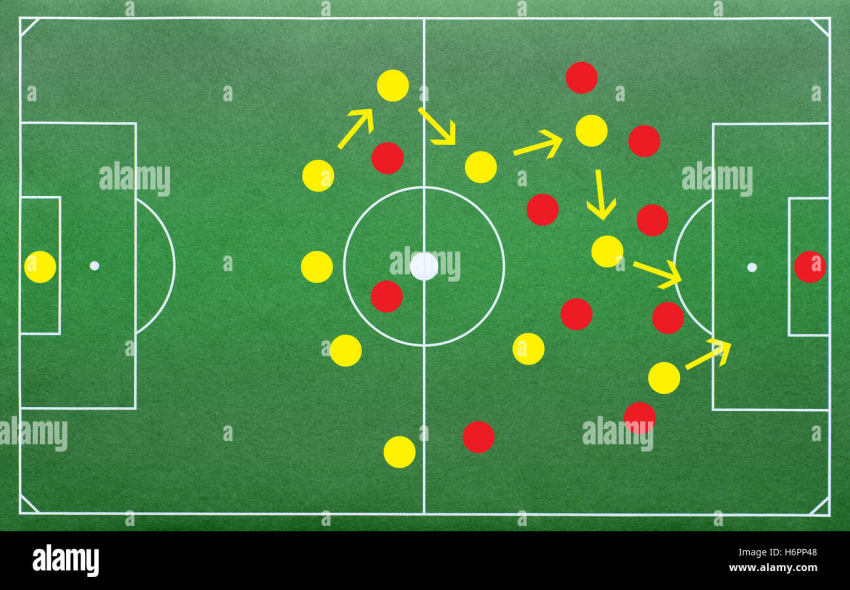Football tactics play a crucial role in shaping the game’s outcome, influencing how teams approach each match on the pitch. These strategies, encompassing intricate tactical formations and winning football strategies, are designed to enhance team performance and gameplay flow. As fans and players alike dive deep into the realm of soccer tactics, they uncover essential elements that differentiate successful teams from their competitors. Understanding the evolving nature of football strategies reveals not just the historical context but also the innovative approaches that define modern play. Whether it’s through a structured 4-3-3 formation or an aggressive pressing style, the mastery of football tactics is instrumental in crafting unforgettable matches.
The art of soccer tactics transcends mere play; it embodies the strategic mindset required to outmaneuver opponents. This intricate web of football strategies, from well-defined positional play to adaptive formations, sets the stage for competitive gameplay. Over the years, sports analysts and coaches have spotlighted various tactical approaches, each contributing to the evolution of the sport. By understanding these tactical systems, fans gain insight into the players’ on-field decisions and how they work collectively towards victory. As we embark on this exploration of effective football gameplay, we will dissect the elements that bring these strategies to life and influence the beautiful game’s different narratives.
Exploring Winning Football Strategies
Winning football strategies encompass a wide array of techniques and methods that teams employ to achieve victory on the pitch. Key among these strategies is the creation of a strong defensive setup that allows for counter-attacks. For instance, teams often analyze their opponent’s plays and adapt their formations in response. By understanding the intricate details of their rivals, they can position players strategically to intercept passes and convert defense into offense quickly. This hands-on adaptability is vital for success, as it enables teams to dominate not only through structured play but also through opportunistic strikes when opponents are vulnerable.
Further examination of winning football strategies reveals how essential it is to capitalize on set pieces. Corner kicks and free kicks can be game-changers when executed well, and teams often spend considerable time devising tactics for these moments. Utilizing players’ specific strengths during these phases can result in scoring opportunities that may not normally arise during the flow of the game. Mastering the art of set pieces adds another layer of complexity and depth to a team’s overall game plan, directly correlating with their success rate during matches.
The Role of Tactical Formations in Football Gameplay
Tactical formations are pivotal in shaping the gameplay within football, serving as the blueprint for how teams execute their strategies on the field. Formations like 4-3-3 and 5-3-2 dictate player positioning and movements, influencing both offensive and defensive maneuvers. Teams often adjust their formations based on the opponent’s style of play, testing the adaptability of their players and the fluidity of their tactics. As formations evolve, they allow managers to exploit weaknesses in the opponent’s structure, leading to more effective teamwork and coordinated efforts on the pitch.
Moreover, the implementation of tactical formations directly impacts player roles and responsibilities. For example, a 4-4-2 formation typically requires wingers to not only support the attack but also to track back defensively. Coaches emphasize this duality during training sessions to enhance players’ understanding of their responsibilities within the formation. This comprehensive grasp of tactical formations is essential as it builds a cohesive unit capable of executing complex strategies and responding dynamically during matches. Awareness of positioning related to tactical setups empowers players to make smarter decisions, enhancing the overall effectiveness of their gameplay.
Frequently Asked Questions
What are the common tactical formations in football strategies?
In football, common tactical formations include the 4-4-2, 4-3-3, and 5-3-2 systems. The 4-4-2 is popular for its balanced defensive structure and quick counter-attacking capability. The 4-3-3 emphasizes attacking play while maintaining midfield support, making it versatile for both offensive and defensive strategies. Conversely, the 5-3-2 focuses on defensive solidity, allowing for counter-attacking opportunities through wing play. Understanding these tactical formations is key to developing effective football strategies.
How do winning football strategies incorporate tactical awareness?
Winning football strategies heavily rely on tactical awareness, which is essential for players to make informed decisions during a match. This involves understanding one’s roles within various formations and adapting to the dynamic flow of the game. Coaches enhance tactical awareness through targeted training sessions and video analysis, helping players recognize their opponents’ tactics and devise effective counter-strategies. By mastering tactical awareness, teams can improve their gameplay execution and overall performance on the pitch, ultimately leading to more victories.
| Tactical Element | Description |
|---|---|
| Introduction to Football Tactics | Explores the need for structured gameplay and how it has evolved over time. |
| Key Formations | – **4-4-2**: Defensive stability with quick counter-attacks. – **4-3-3**: Balances offense and defense with midfield support. – **5-3-2**: Focuses on defense with flexible counter-attacks. |
| Fundamental Tactics | – **Possession-Based Play**: Control the ball to create openings. – **Counter-Attacking Football**: Exploit spaces left by attacking opponents. – **High-Pressing Strategies**: Press opponents to regain possession quickly. |
| Tactical Awareness | Essential for players to adapt in-game, involving good positioning and timing. Coaches aid in developing this awareness. |
| Analyzing Tactical Setups | Successful teams analyze opponents’ tactics to tailor their strategies accordingly. |
Summary
Football tactics are crucial for any fan or player looking to delve deeper into the sport. By understanding the evolution of various formations and core strategic principles such as possession play, counter-attacking, and high pressing, one can appreciate the sophisticated dynamics at play during matches. The meticulous preparation and tactical awareness fostered by coaches greatly influence a player’s performance and decision-making on the field. As football continues to develop, staying informed about modern tactics not only enhances the viewing experience but also enriches the comprehensive understanding of Football Tactics as an essential component of the game.
